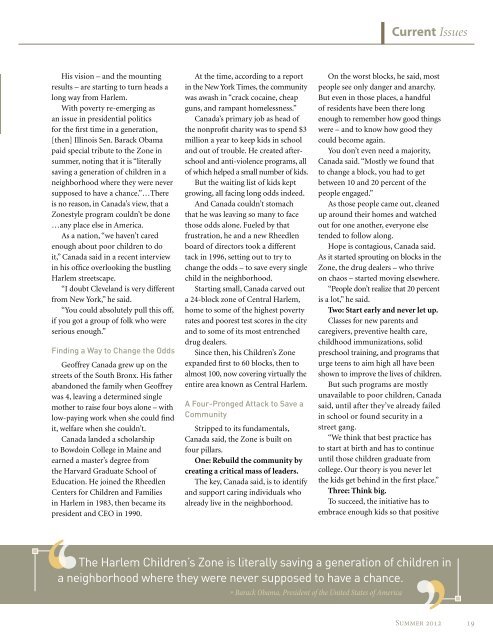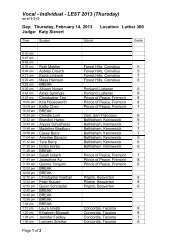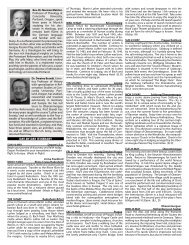Summer 2012 - "Education Perspectives" - Concordia University
Summer 2012 - "Education Perspectives" - Concordia University
Summer 2012 - "Education Perspectives" - Concordia University
Create successful ePaper yourself
Turn your PDF publications into a flip-book with our unique Google optimized e-Paper software.
His vision – and the mounting<br />
results – are starting to turn heads a<br />
long way from Harlem.<br />
With poverty re-emerging as<br />
an issue in presidential politics<br />
for the first time in a generation,<br />
[then] Illinois Sen. Barack Obama<br />
paid special tribute to the Zone in<br />
summer, noting that it is “literally<br />
saving a generation of children in a<br />
neighborhood where they were never<br />
supposed to have a chance.”…There<br />
is no reason, in Canada’s view, that a<br />
Zonestyle program couldn’t be done<br />
…any place else in America.<br />
As a nation, “we haven’t cared<br />
enough about poor children to do<br />
it,” Canada said in a recent interview<br />
in his office overlooking the bustling<br />
Harlem streetscape.<br />
“I doubt Cleveland is very different<br />
from New York,” he said.<br />
“You could absolutely pull this off,<br />
if you got a group of folk who were<br />
serious enough.”<br />
Finding a Way to Change the odds<br />
Geoffrey Canada grew up on the<br />
streets of the South Bronx. His father<br />
abandoned the family when Geoffrey<br />
was 4, leaving a determined single<br />
mother to raise four boys alone – with<br />
low-paying work when she could find<br />
it, welfare when she couldn’t.<br />
Canada landed a scholarship<br />
to Bowdoin College in Maine and<br />
earned a master’s degree from<br />
the Harvard Graduate School of<br />
<strong>Education</strong>. He joined the Rheedlen<br />
Centers for Children and Families<br />
in Harlem in 1983, then became its<br />
president and CEO in 1990.<br />
At the time, according to a report<br />
in the New York Times, the community<br />
was awash in “crack cocaine, cheap<br />
guns, and rampant homelessness.”<br />
Canada’s primary job as head of<br />
the nonprofit charity was to spend $3<br />
million a year to keep kids in school<br />
and out of trouble. He created afterschool<br />
and anti-violence programs, all<br />
of which helped a small number of kids.<br />
But the waiting list of kids kept<br />
growing, all facing long odds indeed.<br />
And Canada couldn’t stomach<br />
that he was leaving so many to face<br />
those odds alone. Fueled by that<br />
frustration, he and a new Rheedlen<br />
board of directors took a different<br />
tack in 1996, setting out to try to<br />
change the odds – to save every single<br />
child in the neighborhood.<br />
Starting small, Canada carved out<br />
a 24-block zone of Central Harlem,<br />
home to some of the highest poverty<br />
rates and poorest test scores in the city<br />
and to some of its most entrenched<br />
drug dealers.<br />
Since then, his Children’s Zone<br />
expanded first to 60 blocks, then to<br />
almost 100, now covering virtually the<br />
entire area known as Central Harlem.<br />
a Four-Pronged attack to Save a<br />
Community<br />
Stripped to its fundamentals,<br />
Canada said, the Zone is built on<br />
four pillars.<br />
One: Rebuild the community by<br />
creating a critical mass of leaders.<br />
The key, Canada said, is to identify<br />
and support caring individuals who<br />
already live in the neighborhood.<br />
Current Issues<br />
On the worst blocks, he said, most<br />
people see only danger and anarchy.<br />
But even in those places, a handful<br />
of residents have been there long<br />
enough to remember how good things<br />
were – and to know how good they<br />
could become again.<br />
You don’t even need a majority,<br />
Canada said. “Mostly we found that<br />
to change a block, you had to get<br />
between 10 and 20 percent of the<br />
people engaged.”<br />
As those people came out, cleaned<br />
up around their homes and watched<br />
out for one another, everyone else<br />
tended to follow along.<br />
Hope is contagious, Canada said.<br />
As it started sprouting on blocks in the<br />
Zone, the drug dealers – who thrive<br />
on chaos – started moving elsewhere.<br />
“People don’t realize that 20 percent<br />
is a lot,” he said.<br />
Two: Start early and never let up.<br />
Classes for new parents and<br />
caregivers, preventive health care,<br />
childhood immunizations, solid<br />
preschool training, and programs that<br />
urge teens to aim high all have been<br />
shown to improve the lives of children.<br />
But such programs are mostly<br />
unavailable to poor children, Canada<br />
said, until after they’ve already failed<br />
in school or found security in a<br />
street gang.<br />
“We think that best practice has<br />
to start at birth and has to continue<br />
until those children graduate from<br />
college. Our theory is you never let<br />
the kids get behind in the first place.”<br />
Three: Think big.<br />
To succeed, the initiative has to<br />
embrace enough kids so that positive<br />
The Harlem Children’s Zone is literally saving a generation of children in<br />
a neighborhood where they were never supposed to have a chance.<br />
» Barack Obama, President of the United States of America<br />
<strong>Summer</strong> <strong>2012</strong><br />
19







